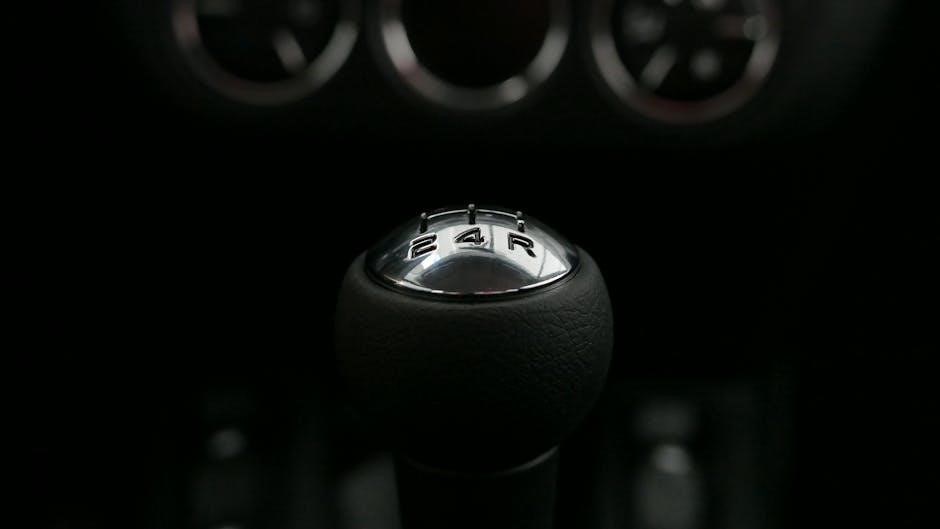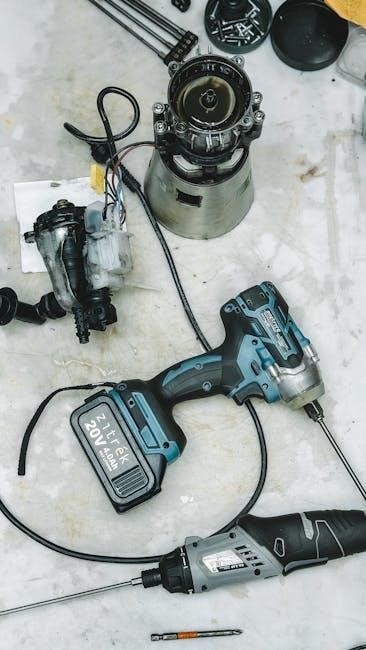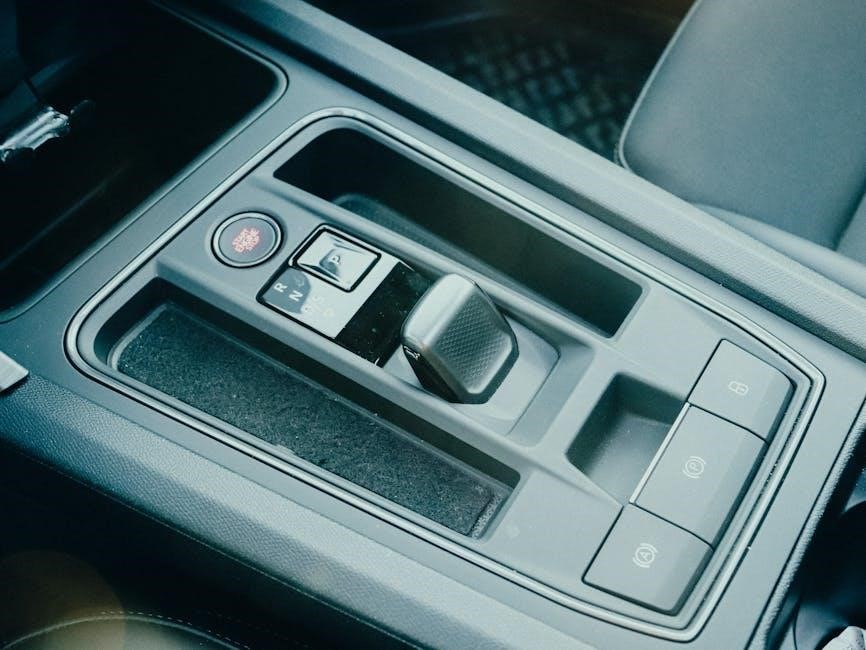Converting a manual transmission to automatic offers enhanced driving convenience and accessibility, especially for urban commuting or drivers seeking a stress-free experience, but requires careful planning and expertise.
1.1 What is a Transmission Conversion?
A transmission conversion involves replacing a vehicle’s manual gearbox with an automatic transmission, requiring mechanical, electrical, and drivetrain modifications. This process includes adapting linkages, integrating electronic controls, and ensuring compatibility with the vehicle’s engine and chassis, often necessitating custom fabrication and professional expertise for a seamless transition.
1.2 Why Convert to an Automatic?
Converting to an automatic enhances driving ease, reducing clutch and gear-shifting effort, ideal for urban traffic. It offers smoother acceleration, improved fuel efficiency, and better maneuverability, making it suitable for drivers seeking convenience. Automatics also provide accessibility for those with physical limitations and can improve towing performance, offering a more relaxed and efficient driving experience overall.
Feasibility of Conversion
Converting a manual to automatic is feasible but complex, requiring professional expertise and careful consideration of vehicle design, cost, and legal factors to ensure compatibility and safety.
2.1 Can You Convert a Manual to Automatic?
Yes, converting a manual to automatic is possible, but it involves significant modifications, including transmission replacement, drivetrain adjustments, and potential electronic integration. The process is complex and typically requires professional expertise to ensure compatibility and functionality, making it a challenging project for DIY enthusiasts without specialized knowledge and tools.
2.2 Factors to Consider Before Conversion
Before converting, evaluate vehicle compatibility, cost, and performance impact. Older models with simpler systems are easier to convert than modern cars with advanced electronics. Budget for transmission, parts, and labor, which can range from $15,000 to $30,000. Ensure compliance with local regulations and consider how the change affects driving dynamics and fuel efficiency. Professional consultation is recommended to avoid unexpected issues.
Step-by-Step Conversion Process
Converting a manual to automatic involves removing the manual transmission, installing the automatic unit, adapting drivetrain components, integrating electronic controls, and thoroughly testing the new system for functionality.
3.1 Removing the Manual Transmission
Removing the manual transmission involves disconnecting the clutch, flywheel, and associated components. Raise the vehicle, access the transmission from underneath, and carefully detach linkages. Drain fluids, remove mounting bolts, and use a transmission jack to safely extract the unit. Ensure all connectors and wiring are disconnected. This step requires precision to avoid damage and prepare for the automatic installation.
3.2 Installing the Automatic Transmission
Installing the automatic transmission begins with mounting it to the engine block, ensuring proper alignment. Custom fabrication may be needed due to size differences. Reconnect drivetrain components, linkages, and electrical systems; Refill fluids and integrate electronic controls, such as the ECU, for smooth operation. This step requires meticulous alignment and connection to ensure compatibility and functionality.
3.3 Adapting Drivetrain and Linkages
Adapting the drivetrain and linkages involves modifying components like driveshafts and axles to ensure compatibility with the automatic transmission. Custom fabrication may be required to accommodate size or alignment differences. The goal is to achieve seamless integration, ensuring proper torque transfer and maintaining vehicle stability. This step is critical for optimal performance and reliability post-conversion.
3.4 Integrating Electronic Controls
Modern automatic transmissions rely on electronic control units (ECUs) to manage shifting and torque distribution. Integrating these systems requires additional wiring, sensors, and programming to ensure compatibility with the vehicle’s electronics. This step involves synchronizing the ECU with the new automatic transmission for smooth operation, which may necessitate professional expertise to avoid system conflicts and ensure reliability.
3.5 Testing the New Transmission
After installing the automatic transmission, comprehensive testing is crucial. This includes evaluating gear shifts, drivetrain performance, and electronic systems functionality. Road testing under various conditions ensures smooth operation and identifies potential issues. Proper testing guarantees reliability, safety, and optimal performance post-conversion.
Advantages of Automatic Transmission
Automatic transmissions offer improved accessibility, reduced driver fatigue, and enhanced maneuverability, making them ideal for urban driving and towing, while also providing a smoother, more convenient driving experience.
4.1 Improved Accessibility
Switching to an automatic transmission enhances accessibility, benefiting drivers with physical limitations or those who struggle with manual shifting. It simplifies driving, especially in heavy traffic, reducing stress and fatigue while making the vehicle more inclusive for a broader range of drivers.
4.2 Enhanced Driving Experience
An automatic transmission offers a smoother and more seamless driving experience, eliminating the need for constant gear shifting. This allows drivers to focus on the road, making city commutes and long drives more enjoyable. The reduced effort required enhances comfort, particularly in stop-and-go traffic, contributing to a more relaxed and pleasant journey overall.
4;3 Better Maneuverability
Converting to an automatic transmission improves maneuverability, especially in low-speed or tight spaces. Smooth, seamless gear shifts eliminate the risk of stalling, making parking and navigating heavy traffic easier. The absence of a clutch pedal reduces driver fatigue, allowing greater focus on steering and control, enhancing overall vehicle handling and responsiveness in various driving conditions.
Challenges and Risks
Converting a manual to automatic involves technical complexities, potential system incompatibilities, and significant costs, requiring professional expertise to ensure reliability and safety post-conversion.
5.1 Technical Difficulties
Technical challenges include replacing the manual transmission with an automatic gearbox, modifying drivetrain components, and integrating electronic controls. Compatibility issues with engine and chassis systems can arise, requiring custom fabrication and wiring. Modern automatics often rely on advanced ECUs, adding complexity to the installation process.
5.2 Potential Risks
Potential risks include reduced fuel efficiency and altered performance characteristics due to automatic transmission’s inherent design. Additionally, improper installation can lead to mechanical failures, safety hazards, and costly repairs. Legal and regulatory compliance issues may also arise, affecting the vehicle’s certification and insurance status.

Cost Considerations
Converting a manual to automatic transmission can range from $15,000 to $30,000, depending on parts, labor, and vehicle specifics, making it a significant financial investment.
6.1 Overall Cost of Conversion
The overall cost of converting a manual transmission to automatic typically ranges from $15,000 to $30,000, depending on the vehicle, transmission type, and labor costs. This includes purchasing the automatic transmission, modifying the drivetrain, and integrating electronic controls. Additional expenses may arise from custom fabrication and compatibility adjustments, making it a significant financial investment requiring careful budgeting and professional consultation for accurate estimates.
6.2 Factors Influencing Cost
Several factors influence the cost of converting a manual to automatic transmission, including the vehicle’s make and model, transmission compatibility, drivetrain modifications, labor costs, and custom fabrication needs; Additionally, the complexity of integrating electronic controls and potential upgrades to the vehicle’s electronics or wiring can significantly impact the overall expense, making each conversion unique and costly.

DIY vs Professional Installation
DIY conversion can be cost-effective but demands advanced mechanical skills, while professional installation ensures safety, reliability, and proper integration, especially with modern electronic systems and drivetrain modifications.
7.1 Pros and Cons of DIY
DIY conversion offers cost savings and a sense of accomplishment but requires advanced mechanical expertise and time. Risks include potential errors, compatibility issues, and safety hazards without proper knowledge and tools.
7.2 Benefits of Professional Installation
Professional installation ensures a seamless and reliable conversion, leveraging expert knowledge and specialized tools; It minimizes risks of errors, guarantees compatibility, and provides warranty coverage, resulting in a safer and more efficient transmission system tailored to your vehicle’s specifications.
Maintenance Requirements
Regular fluid changes, torque converter checks, and monitoring seals are crucial. Proper care ensures smooth operation and longevity of the automatic transmission system.
8.1 Automatic Transmission Maintenance
Regular maintenance is essential for optimal performance. Ensure fluid levels are checked and changed as recommended. Inspect the torque converter and transmission seals for leaks. Clean the transmission pan and replace the filter during servicing. Refer to the service manual for specific intervals and procedures to maintain the health of your automatic transmission system.
8.2 Long-Term Care
For long-term reliability, maintain consistent transmission fluid changes and monitor for signs of wear. Avoid extreme driving conditions and ensure proper cooling. Regular inspections by a professional can prevent major repairs. Adhere to the recommended service intervals to extend the lifespan of your automatic transmission and ensure optimal performance over time.
Legal and Regulatory Considerations
Ensure your transmission conversion complies with local emissions and safety standards. Obtain necessary approvals and inspections to avoid legal complications. Requirements may vary by region.
9.1 Emissions and Safety Standards
Converting a manual to an automatic transmission must meet strict emissions and safety regulations. Ensure the new system aligns with local environmental standards and maintains vehicle safety features. Modifications may require inspections and certifications to guarantee compliance, avoiding potential legal issues and ensuring roadworthiness. Always consult local authorities for specific requirements.
9.2 Legal Implications
Converting a manual to an automatic transmission may raise legal concerns. Ensure the modification complies with local vehicle regulations, as unauthorized changes can lead to registration issues or fines. Some jurisdictions require inspections or certifications for major drivetrain alterations. Always verify legal requirements with local authorities to avoid penalties and ensure the vehicle remains road-legal.

Vehicle Compatibility and Suitability
Not all vehicles are suitable for manual-to-automatic conversion. Compatibility depends on the vehicle’s make, model, and drivetrain design. Assessing individual suitability is crucial for a successful conversion.
10.1 Which Vehicles Are Best for Conversion?
Certain vehicles are better suited for manual-to-automatic conversion due to their drivetrain compatibility and design simplicity. Older vehicles with less complex electronic systems are generally easier to convert. Compatibility varies across makes and models, so it’s essential to check specific requirements before proceeding with the conversion process.
10.2 Checking Compatibility
Checking compatibility involves assessing the vehicle’s drivetrain, engine specifications, and electronic systems. Ensuring the automatic transmission is compatible with the engine and drivetrain is crucial. Additionally, evaluating the space constraints and wiring requirements helps determine the feasibility of the conversion; Professional consultation is recommended to avoid potential issues and ensure a smooth transition to an automatic system.
Future-Proofing Your Vehicle
Modernizing your car with an automatic transmission aligns it with technological trends, enhancing its appeal and ensuring it remains relevant in the evolving automotive landscape.
11.1 Modernizing Your Car
Upgrading to an automatic transmission modernizes your vehicle, offering enhanced convenience and ease of driving, especially in urban settings. It aligns with contemporary driving preferences, reducing manual effort and stress. Modern automatic systems integrate seamlessly with advanced technologies, improving overall performance. This conversion future-proofs your car, making it more appealing for future buyers and aligning it with evolving automotive trends.
11.2 Keeping Up with Technology
Converting to an automatic transmission aligns your vehicle with modern automotive advancements, including electronic controls and adaptive software. This enhances fuel efficiency and driving smoothness, particularly in urban environments. By embracing current technologies, your car remains compatible with future innovations, ensuring long-term relevance and performance. This modernization also reduces driver fatigue, offering a more enjoyable and stress-free driving experience.
Troubleshooting Common Issues
Common issues post-conversion include mechanical malfunctions, software glitches, or drivetrain misalignment. Early detection and professional repair are crucial to ensure optimal performance and reliability of the automatic system.
12.1 Common Post-Conversion Issues
Post-conversion issues may include slipping gears, incorrect gear shifts, or torque converter malfunctions. Electrical faults in sensors or solenoids can disrupt automatic shifting, while drivetrain misalignment may cause vibrations. Addressing these promptly prevents further damage and ensures smooth operation, requiring diagnostic tools and specialized expertise for effective resolution.
12.2 Solutions and Repairs
Solutions include recalibrating the ECU, inspecting drivetrain alignment, and replacing faulty sensors or solenoids. Flushing transmission fluid and checking electrical connections can resolve slipping or erratic shifting. Professional inspection and adjustments are often necessary to ensure proper functionality, while software updates may correct electronic control issues, restoring smooth and reliable automatic transmission performance.
Converting a manual to automatic transmission is complex but offers enhanced convenience and accessibility, making it a viable option for those seeking a smoother driving experience. Professional expertise is often essential to ensure reliability and performance.
13.1 Final Thoughts on Conversion
Converting a manual to automatic transmission is a complex yet rewarding process, offering improved accessibility and convenience. While it requires significant expertise and investment, the benefits of enhanced driving ease and reduced effort make it a viable option for those seeking a modernized vehicle. Professional guidance is essential to ensure a seamless and reliable transition.
13.2 Is It Worth It?
Converting a manual to automatic can be worthwhile for improved convenience, reduced driver fatigue, and enhanced accessibility, especially for urban driving or physically challenged individuals. However, the high cost and complexity may outweigh benefits for some, making it essential to weigh personal needs, budget, and vehicle suitability before deciding.
References and Further Reading
For detailed guides, technical insights, and expert opinions, consult reputable automotive websites, forums, and manufacturer resources specializing in transmission conversions for comprehensive information.
14.1 Recommended Resources
Explore detailed guides on Hollywood Garage PA and Naija Car News for transmission conversion insights. Forums like Team-BHP offer real-world experiences and expert advice. These resources provide technical tips, cost estimates, and step-by-step instructions for a successful manual-to-automatic conversion process.
14.2 Expert Opinions
Experts emphasize that manual-to-automatic conversion is complex, requiring professional expertise. Automotive specialists recommend consulting trusted mechanics or transmission shops to ensure compatibility and reliability. Modern vehicles with advanced electronic systems may need custom solutions, making DIY approaches risky. Professionals stress the importance of thorough planning and budgeting for a seamless transition.

Frequently Asked Questions
Is converting a manual to automatic transmission feasible, cost-effective, and worth the effort for improved driving convenience and reduced long-term maintenance requirements today?
15.1 Common Queries
Common questions include whether converting a manual to automatic is feasible, cost-effective, and worth the effort. Drivers also inquire about the process complexity, required expertise, and potential impact on vehicle performance and maintenance. Additionally, many ask if DIY conversions are advisable or if professional installation is recommended for reliability and safety.
15.2 Expert Answers
Experts agree that manual-to-automatic conversions are feasible but complex, requiring professional expertise. Costs range widely, depending on the vehicle and transmission type. DIY attempts are discouraged due to technical challenges and potential reliability issues. Proper planning, including compatibility checks and legal compliance, is essential. Ensure the conversion aligns with your driving needs and budget for a successful outcome.